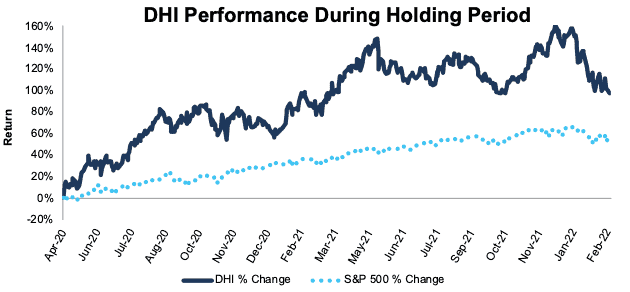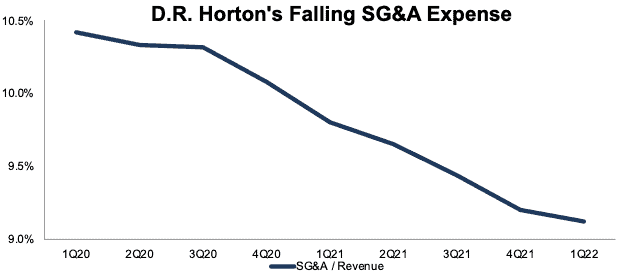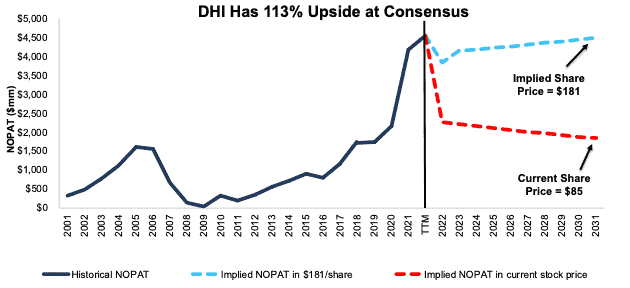We made D.R. Horton Inc. (DHI: $85/share) a Long Idea in April 2020, as part of our “See Through the Dip” thesis. Since then, the stock is up 101% compared to a 55% gain for the S&P 500. Despite its large outperformance, the stock could be worth $181+/share – another 100%+ upside. Our most recent report on D.R. Horton, from March 2021, is here.
We leverage more reliable fundamental data, as proven in The Journal of Financial Economics[1], with qualitative research to pick this Long Idea. Our proprietary research provides a new source of alpha.
D.R. Horton Is Loaded With Upside
- D.R. Horton has been the largest homebuilder (by total closings) in the U.S. since 2002.
- Demand for housing will persist in the near term because the national housing supply remains below its historical average.
- The willingness for government to intervene in housing finance mitigates the risk of rising interest rates.
- Despite rising labor and material costs across the homebuilding industry, D.R. Horton is realizing greater scale, which helps protect its margins.
- The stock has 118% upside with moderate profit growth.
Figure 1: Long Idea Performance: From Date of Publication Through 2/15/2022
Sources: New Constructs, LLC and company filings
What’s Working
Strong Fiscal 1Q22 Performance: D.R. Horton continues to grow revenue and profits as strong housing demand provides a significant tailwind. The company’s fiscal 1Q22 (FYE is 9/30) revenue rose 19% year-over-year (YoY), in large part due to the average closing price of homes sold rising 19% over the same time. Core Earnings rose 47% YoY from $796 million in fiscal 1Q21 to $1.2 billion in fiscal 1Q22.
Improving Profitability: Longer term, the company’s net operating profit after tax (NOPAT) margin rose from 7% in fiscal 2016 to 16% over the trailing-twelve-month (TTM) period, while invested capital turns rose from 1.0 to 1.4. Rising NOPAT margins and invested capital turns drive D.R. Horton’s return on invested capital (ROIC) from 7% in fiscal 2016 to 22% TTM.
Scale Is Driving Efficiencies: D.R. Horton’s net sales orders in fiscal 1Q20 were 13,126. In fiscal 1Q22, net sales orders rose 64% to 21,522. Expanding operations are driving economies of scale, as evidenced by TTM Selling, General, and Administrative expense as a percentage of TTM revenue falling from 10.4% in fiscal 1Q20 to 9.1% in fiscal 1Q22.
Figure 2: TTM Selling, General & Administrative Expense / Revenue: 1Q20 – 1Q22
Sources: New Constructs, LLC and company filings
Positioned for Long-term Growth: The average number of single-family housing starts grew from 1.2 million in 2017 to nearly 1.6 million in 2021. The National Association of Homebuilders expects housing starts in 2022 and 2023 to grow above 2021 levels. With an average closing price of $361,800 in fiscal 1Q22, the company primarily targets entry-level buyers, a segment of the market where a significant backlog of demand remains.
The company plans to meet the strong demand for housing by increasing its inventory to 54,800 homes in fiscal 1Q22, up 30% from the prior year.
Looking ahead, D.R. Horton is positioned to grow profits as it expects to close ~91,000 homes in fiscal 2022, an 11% increase over fiscal 2021.
What’s Not Working
Slowing Growth: The company’s net sales orders growth of 5% YoY in fiscal 1Q22 is far less than the 56% YoY growth in fiscal 1Q21. Nobody expected the company to match growth rates achieved at the time demand was surging, but supply chain disruptions also slowed net sales orders. However, despite the slowdown in fiscal 2021, the company is guiding for “double-digit volume growth in fiscal 2022”.
Rising Material and Labor Costs: While the company’s cost of sales per square foot rose 2.9% quarter-over-quarter (QoQ) in fiscal 1Q22, its revenue rose 3.4% QoQ. Even though material and labor costs are rising, the company has successfully passed them through to customers, a trend we expect to continue given the strength of the current housing market.
While labor and supply chain problems have negatively impacted the company’s operations, D.R. Horton can leverage its industry-leading scale to better manage these industry-wide problems. As a result, we expect the company to take even more market share from builders with less scale and operational efficiency.
Rising Interest Rates: It is no secret that higher rates make housing less affordable for customers. However, D.R. Horton’s large position in the more-affordable, entry-level segment of the housing market means it can benefit from consumers moving down-market to find affordability.
Despite the recent rise in interest rates, rates are still historically low, and new home demand is still historically strong. However, if rising interest rates begin to make housing unaffordable for too many people, government intervention is likely to expand current assistance programs or even introduce new legislation to encourage more affordable housing. As an entry-level home builder, DHI will definitely benefit from any government intervention to support home ownership and, therefore, homebuilding.
D.R. Horton Is Priced For a Permanent 60% Profit Decline
D.R. Horton’s price-to-economic book value (PEBV) ratio of 0.4 means the stock is priced for profits to fall, permanently, by 60% from TTM levels. Below, we use our reverse discounted cash flow (DCF) model to analyze the expectations for future growth in cash flows baked into a couple of stock price scenarios for D.R. Horton.
In the first scenario, we assume D.R. Horton’s:
- NOPAT margin falls to 8% (20-year average vs. 16% TTM) from fiscal 2022 – 2031, and
- revenue falls by 2% (vs. consensus CAGR of +17% for fiscal 2022 – 2023) compounded annually from fiscal 2022 – 2031.
In this scenario, D.R. Horton’s NOPAT falls 8% compounded annually over the next decade and the stock is worth $83/share today – equal to the current price. For reference, D.R. Horton grew NOPAT by 36% compounded annually over the past 10 years.
D.R. Horton’s Shares Could Reach $181 or Higher
If we assume D.R. Horton’s:
- NOPAT margin falls to 11% (five-year average) from fiscal 2022 – 2031,
- revenue grows at a 17% CAGR from fiscal 2022 – 2023 (equal to consensus), and
- revenue grows by 1% compounded annually from fiscal 2024 – 2031, then
the stock is worth $181/share today – 113% above the current price. In this scenario, D.R. Horton’s NOPAT in fiscal 2031 is still 1% below TTM levels. Should D.R. Horton grow NOPAT more in line with historical growth rates, the stock has even more upside.
Figure 3: D.R. Horton’s Historical and Implied NOPAT: DCF Valuation Scenarios
Sources: New Constructs, LLC and company filings
This article originally published on February 16, 2022.
Disclosure: David Trainer owns DHI. David Trainer, Kyle Guske II, and Matt Shuler receive no compensation to write about any specific stock, sector, style, or theme.
Follow us on Twitter, Facebook, LinkedIn, and StockTwits for real-time alerts on all our research.
[1] Our research utilizes our Core Earnings, a more reliable measure of profits, as proven in Core Earnings: New Data & Evidence, written by professors at Harvard Business School (HBS) & MIT Sloan and published in The Journal of Financial Economics.



